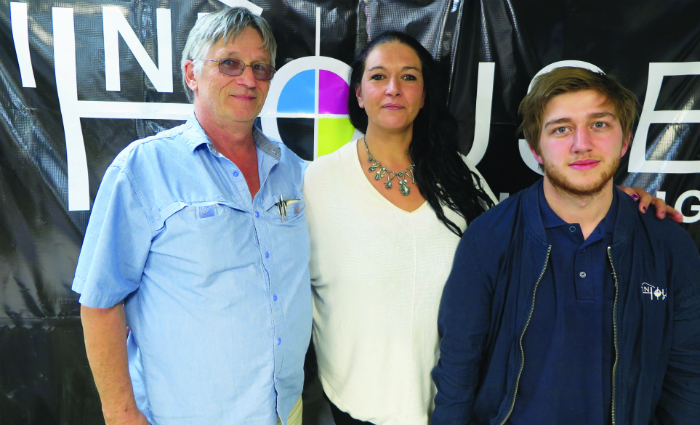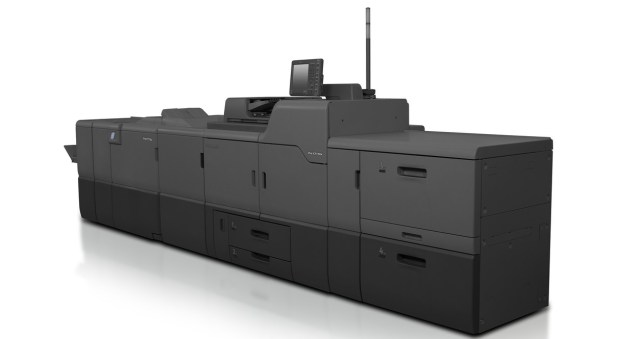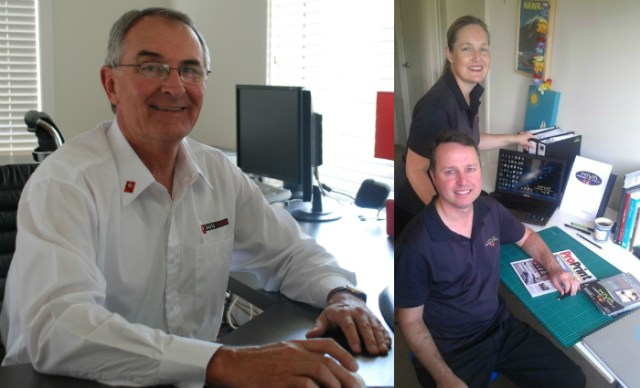
At a glance, InHouse Print and Design seems like your quintessential small family printer. It sits in a light industrial suburb on Brisbane’s southern outskirts on the same street as half a dozen other small printers. Three generations of the family work side-by-side in a cluttered factory that can only be described as organised chaos. But this is not just another small family printer, it is one that has managed to grow 40 per cent in two consecutive years. It is a printer that knows ink on paper in 2015 is a commodity, and there is not much margin in commodities like print these days. With demand falling or at best maintaining, let alone growing, your business is tough. You have to think outside the box if you want to succeed. That is exactly what InHouse has done, and the payoff is a jump in turnover from $1.2m to $2m in one year, from less than $800,000 the year before.
Publishing
Short-run book printing has long been InHouse’s biggest market, worth 40 per cent of the company’s print revenue. It has multiple Ricoh digital production printers churning out 10 new titles a week with average runs of 200-300 and up to 3000. The printers include a new Pro C7100 bought earlier this year and was soon to be joined by Australia’s first Pro C9100. But printing is only one part of the process from when an author gets a cracking idea to when it entertains a reader sitting in the sun flipping the pages. “You don’t have as much control over the process, and there is always a lot of drama communicating between the author and the publisher,” general manager Nevada Matthews says. “Our success is built on going the extra mile for clients and if someone else messes something up we can’t deliver.” So in March 2014, the company launched InHouse Publishing – its own indie publishing house that can take a fledgling author from their first manuscript to a bookstore shelf.
The business has four staff led by 16-year publishing veteran Ocean Reeve, and has now published 350 authors and is worth $500,000 without even counting the printing. The authors include Lindsay Chamberlain, and Reeve is in negotiations to bring William Shatner’s self-help book Catch Me Up to Australia, after saving the e-book version from a formatting disaster. Reeve says he regularly works 13 hours a day as business is booming. So far about 100 authors have sold more than 500 copies and some have sold over 2000. It also does e-books, some of which have made bestseller lists.
Matthews says part of the appeal for its clients, like a lot of first-time authors and religious groups, is they do not want to be taken advantage of by big publishing companies and want to keep the rights to their work and see meaningful returns. “We always liked the idea of self-published books because it keeps the rights in the author’s name,” he says. “This is a way of doing that while helping them distribute to a wider audience.” Like the rest of InHouse, the business has grown almost entirely from word of mouth as clients see results and tell their friends. “Clients trust us to advise them because we have built relationships on honesty and telling them how it is,” Matthews says. “We are the most passionate about this part of our business because it such a deep and real thing and so important to the people who come to us and entrust us with their work.”
Reeves says the team will first do an appraisal of the manuscript to assess its quality and then either send it back for rewriting or move it to editing and proofreading. InHouse will then design the cover and format the book to a standard you would expect to see in a library or bookshop, and send it to printing for a proof copy. “That is when the author gets to physically see their baby in their hands. It is a pretty big moment that many are not prepared for,” he says. Reeves will work with them to set retail price, work out a target audience, and a strategy to make their money back in the first print run. The books are mainly sold to libraries and independent bookshops, but on the morning ProPrint visited he was in negotiations to distributed through QBD bookshops, and has just closed a deal to sell to all libraries in New Zealand. Everything is done print on demand, instead of on consignment, so books are not sent back, unless damaged, if they are not sold. “Most self-publishing services leave authors on their own for marketing, but we don’t,” he says. “We need the authors to be selling with confidence because that is how everyone makes money.”
Widening markets
Wide format is the other growth area that has helped push InHouse above the turnover where the Federal Government will give it a small business tax break. The initial plan was to immediately import a functioning department by merging with Brisbane wide format printer Queensland Posters last year, but that did not go as planned and was over in just a few months. Matthews says the bigger clients did not make the transition and InHouse’s older Roland machine was not equipped to handle the necessary volume. Only a few small clients remained and one day former Queensland Posters owner Marc Flemington just called up and said it was not working out and he would go his own way. “While Marc gave it a good go it didn’t work out from a business perspective,” Matthews says.
“We got some good insights into the wide format industry and learned a lot about how to run it, and that was the biggest benefit form the whole thing and helped us kickstart the business to what it is today.” Matthews’ aunt and InHouse head designer Chrisstie Matthews says the family had high hopes but it didn’t pan out. “We were dealing with someone who was not as motivated to push things forward as we were and it was actually becoming quite a drag on the business,” she says. “You’ve got to think success in business and you have to surround yourself with people who think the same way.”
InHouse rebounded from this disappointment at the beginning of the year when it bought a Flora 2512 digital flatbed printer that Matthews says has made it able to offer the cheapest printed corflute signs in Australia and is economical no matter what quantity. “It can do as many or as little as you want and be the cheapest across the board in Australia,” he says. Matthews says this is because of the printer’s speed and the ink price, and that InHouse has good relationships with suppliers that means it get cheap corflute, cheap enough to print a standard sized corflute sign for $4.30. The machine can produce 24 to 67sqm an hour depending on quality, with a print area of 2.54 x 1.22 metres. “On a really good day the Roland could do about 50-60, this one can do 700- 800. The biggest run so far is a couple of thousand 600×900 signs,” he says. The Flora came just in time for InHouse to compete for work on the Queensland state election in January. Matthews says other printers were overloaded so the company sent out emails to agencies handling it to say it could produce corflute advertising for lawns signs another other locations in 24 hours no matter what. “That was a pretty crazy month but it worked and now we know a lot of people in all the political parties who know we can deliver and will not only use us next time but tell their friends about us,” he says. InHouse followed up with the NSW state election in March where it was cheaper to print in Brisbane and ship it down.
InHouse’s wide format operations now also include posters, pull up banners, ACM panels, and one way vision among others, with the Flora so versatile the range of jobs is huge. “If it is flat, clean and under 100mm thick, you can print on it. We have done doors, chunks of wood, glass,” Matthews says. Work is gained by word of mouth and by calling or emailing other printers to see what they need doing. Some printers have shut down their wide format operations entirely, especially ones using screen printers, to outsource to InHouse, so they can focus on core business. As well as trade work, which makes up half the revenue, major clients include building sites and real-estate agents. Matthews says the company gained 15 new clients the week ProPrint visited.
Keeping it in the family
Matthews himself is emblematic of InHouse’s approach to staffing. The grandson of managing director Bob Karlsson, he is just 18 years old and joined the business a year ago straight out of high school with zero print knowledge. “I didn’t even know what an A4 piece of paper was,” he says. Now he knows everything there is to know about the business, oversees all the quotes and estimating and Karlsson trusts him to run everything and the staff take their cues from him. In just half an hour during ProPrint’s interview, five staff poked their heads into his office with questions or to ask for instructions. His uncle Guy Kirk runs the wide format business and his aunt Chrisstie co-founded the business with Karlsson. To keep cost down all staff are multi-trained so everyone can do everything and work can continue no matter what. Matthews says staff are hired mostly based on their attitude and then trained to do everything. “We have young staff who started with no print experience and are now able to run most of the machines and are contributing to the company’s success,” he says. “People working hard 10 hours a day every day, rarely taking a sickie.” Staff numbers have doubled in the past year thanks to adding the publishing department, extra book printing work created from publishing, and wide format ramping up.
Matthews says the family has built business solely on word of mouth on the assumption that if you do a good job people will advertise your business for you. “It is just being successful, fast and honest the whole time every time, because a happy customer tells five people but an upset one tells 10,” he says. “We have very few upset customers and we will always make it right even if not our fault.” InHouse has no sales reps out on the road because it is not really their thing to be pushy. “It is not what we are about,” Matthews says. The company is planning to do more with its website and other methods to get its name out there and generate more leads. He says half whole business is trade, graphic designers and agencies, and the wide format section is increasingly attracting agency work.
Growing with new technology
Matthews says InHouse tries to stay up to date with the latest printing technology because it allows it to stay competitive and produce a wider range of products at fast speeds. The next target is to snatch offset jobs as digital progressively gets the quality, speed, and volume to replace it. He says the new Ricoh Pro C9110 digital printer that will soon be installed will make the company price competitive with offset on colour printed books, to the point where it can bring back work from offshore. It will also use it for flyers, business cards, commercial printing.
Further down the track, Matthews says the plan is to invest in high-speed quality inkjet as an offset replacement when the technology catches up. “The way we see the future heading is inkjet, we hope it will completely eliminate offset for all but the longest runs and allow Australian printers to compete with Asia,” he says. “Digital printing has grown with us and it will continue to grow – it has gone form 100 flyers to 10,000 to 20,000 and it will get bigger and bigger.”
He says InHouse has barely outsourced since installing the C7100 but as it gets more business it will need different technology to keep it that way. “As we grow the business we want to be able to do runs of say 10,000 colour books which right now we would have to outsource.”
He thinks in two or three years the technology will be at the point where it is competitive on all paper types, and that is when InHouse will go to the next level.
Family values
Bob Karlsson and his daughter Chrisstie Matthews started InHouse 16 years ago armed with just a bubble jet printer. “We were all working in the printing industry, him as a print manager for Queensland Newspapers and I worked in the publishing department so we had a bit of experience and we thought ‘it can’t be that hard, let’s do it’,” Matthews says. “We decided this while Mum was on holidays so it was a bit sneaky and was not received very well when she came back – she thought we were a bit nuts. But we stuck to our guns and have come a long way from having to finance our first bubble jet printer we bought from Harvey Norman.”
Their first job, an order of business cards, was a disaster. “I taught myself graphic design and spent three weeks figuring out how to turn the E backwards on her cards, and she laughed at us, gave the cards straight back and said we were a joke, but we kept going,” Matthews says. The second job for Just Cars went a lot better. “They are still a client of ours and in fact called with a job half an hour ago,” Karlsson says. “They and our next customer Sparkrite Electrical have grown with us. We have formed a lot of close relationships because as a family business we treat our customers like family too. That is the most important thing, it’s not always about bottom line. Every business has to make money, but it’s also about the people we deal with.” Karlsson admits he is usually not the best person to deal with clients, especially if there are problems, because he ‘calls a spade a spade’ so the job usually falls to Matthews. “Sometimes there are clients that are not right for us and when I’ve had enough with dealing with them, I know dad has my back,” she says.
Comment below to have your say on this story.
If you have a news story or tip-off, get in touch at editorial@sprinter.com.au.
Sign up to the Sprinter newsletter


